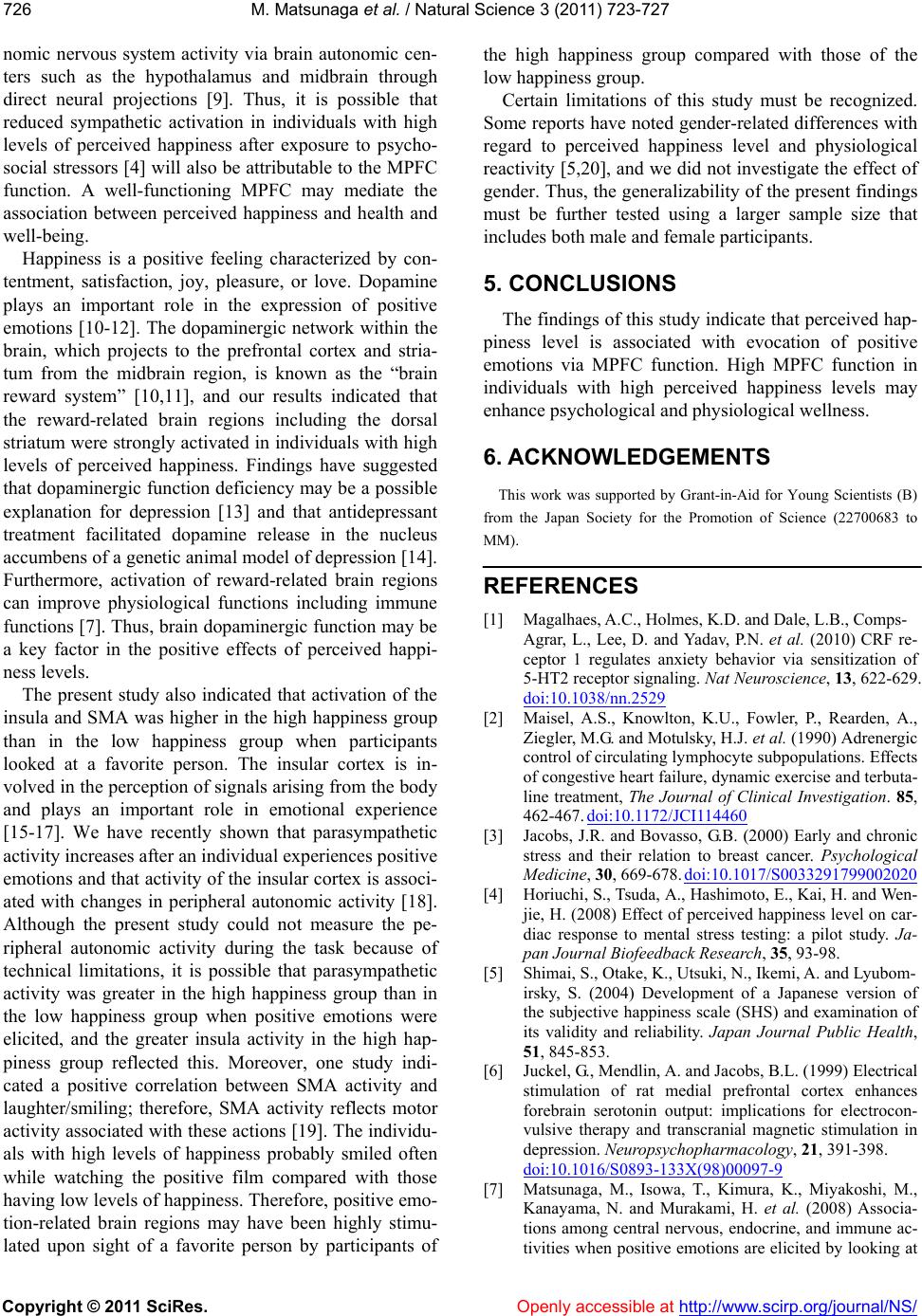
M. Matsunaga et al. / Natural Science 3 (2011) 723-727
Copyright © 2011 SciRes. Openly accessible at http://www.scirp.org/journal/NS/
726
nomic nervous system activity via brain autonomic cen-
ters such as the hypothalamus and midbrain through
direct neural projections [9]. Thus, it is possible that
reduced sympathetic activation in individuals with high
levels of perceived happiness after exposure to psycho-
social stressors [4] will also be attributable to the MPFC
function. A well-functioning MPFC may mediate the
association between perceived happiness and health and
well-being.
Happiness is a positive feeling characterized by con-
tentment, satisfaction, joy, pleasure, or love. Dopamine
plays an important role in the expression of positive
emotions [10-12]. The dopaminergic network within the
brain, which projects to the prefrontal cortex and stria-
tum from the midbrain region, is known as the “brain
reward system” [10,11], and our results indicated that
the reward-related brain regions including the dorsal
striatum were strongly activated in individuals with high
levels of perceived happiness. Findings have suggested
that dopaminergic function deficiency may be a possible
explanation for depression [13] and that antidepressant
treatment facilitated dopamine release in the nucleus
accumbens of a genetic animal model of depression [14].
Furthermore, activation of reward-related brain regions
can improve physiological functions including immune
functions [7]. Thus, brain dopaminergic function may be
a key factor in the positive effects of perceived happi-
ness levels.
The present study also indicated that activation of the
insula and SMA was higher in the high happiness group
than in the low happiness group when participants
looked at a favorite person. The insular cortex is in-
volved in the perception of signals arising from the body
and plays an important role in emotional experience
[15-17]. We have recently shown that parasympathetic
activity increases after an individual experiences positive
emotions and that activity of the insular cortex is associ-
ated with changes in peripheral autonomic activity [18].
Although the present study could not measure the pe-
ripheral autonomic activity during the task because of
technical limitations, it is possible that parasympathetic
activity was greater in the high happiness group than in
the low happiness group when positive emotions were
elicited, and the greater insula activity in the high hap-
piness group reflected this. Moreover, one study indi-
cated a positive correlation between SMA activity and
laughter/smiling; therefore, SMA activity reflects motor
activity associated with these actions [19]. The individu-
als with high levels of happiness probably smiled often
while watching the positive film compared with those
having low levels of happiness. Therefore, positive emo-
tion-related brain regions may have been highly stimu-
lated upon sight of a favorite person by participants of
the high happiness group compared with those of the
low happiness group.
Certain limitations of this study must be recognized.
Some reports have noted gender-related differences with
regard to perceived happiness level and physiological
reactivity [5,20], and we did not investigate the effect of
gender. Thus, the generalizability of the present findings
must be further tested using a larger sample size that
includes both male and female participants.
5. CONCLUSIONS
The findings of this study indicate that perceived hap-
piness level is associated with evocation of positive
emotions via MPFC function. High MPFC function in
individuals with high perceived happiness levels may
enhance psychological and physiological wellness.
6. ACKNOWLEDGEMENTS
This work was supported by Grant-in-Aid for Young Scientists (B)
from the Japan Society for the Promotion of Science (22700683 to
MM).
REFERENCES
[1] Magalhaes, A.C., Holmes, K.D. and Dale, L.B., Comps-
Agrar, L., Lee, D. and Yadav, P.N. et al. (2010) CRF re-
ceptor 1 regulates anxiety behavior via sensitization of
5-HT2 receptor signaling. Nat Neuroscience, 13, 622-629.
doi:10.1038/nn.2529
[2] Maisel, A.S., Knowlton, K.U., Fowler, P., Rearden, A.,
Ziegler, M.G. and Motulsky, H.J. et al. (1990) Adrenergic
control of circulating lymphocyte subpopulations. Effects
of congestive heart failure, dynamic exercise and terbuta-
line treatment, The Journal of Clinical Investigation. 85,
462-467. doi:10.1172/JCI114460
[3] Jacobs, J.R. and Bovasso, G.B. (2000) Early and chronic
stress and their relation to breast cancer. Psychological
Medicine, 30, 669-678. doi:10.1017/S0033291799002020
[4] Horiuchi, S., Tsuda, A., Hashimoto, E., Kai, H. and Wen-
jie, H. (2008) Effect of perceived happiness level on car-
diac response to mental stress testing: a pilot study. Ja-
pan Journal Biofeedb ack Research, 35, 93-98.
[5] Shimai, S., Otake, K., Utsuki, N., Ikemi, A. and Lyubom-
irsky, S. (2004) Development of a Japanese version of
the subjective happiness scale (SHS) and examination of
its validity and reliability. Japan Journal Public Health,
51, 845-853.
[6] Juckel, G., Mendlin, A. and Jacobs, B.L. (1999) Electrical
stimulation of rat medial prefrontal cortex enhances
forebrain serotonin output: implications for electrocon-
vulsive therapy and transcranial magnetic stimulation in
depression. Neuropsychopharmacology, 21, 391-398.
doi:10.1016/S0893-133X(98)00097-9
[7] Matsunaga, M., Isowa, T., Kimura, K., Miyakoshi, M.,
Kanayama, N. and Murakami, H. et al. (2008) Associa-
tions among central nervous, endocrine, and immune ac-
tivities when positive emotions are elicited by looking at